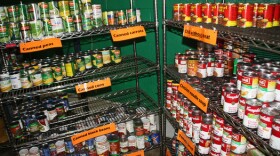An annual snapshot of food insecurity shows Kentucky is making some strides in the fight to end hunger.
The Map the Meal Gap 2017 report by Feeding America released Thursday tracks who is struggling with hunger and where they live.
According to the findings, Kentucky's food insecurity rate of 16 percent fell about 1 percent from last year.
Food insecurity rates are down overall since 2011, and Tamara Sandberg, executive director of the Kentucky Association of Food Banks, says she's thrilled to see the improvement.
"That gives us hope that there is a solution to hunger in Kentucky and we're working to find it,” she states. “We believe the public/private partnerships that we see in Kentucky are part of the reason we're seeing progress made in the fight against hunger, such as the Department of Agriculture Commissioner Ryan Quarles' hunger initiative."
Sandberg notes that progress needs to continue. The state's food insecurity rate is still higher than the national average of 14 percent, with nearly 700,000 Kentuckians, including more than 200,000 children, unsure where they will get their next meal.
Food insecure people in Kentucky face an average food budget shortfall of $15.79 each week.
Michael Halligan, chief executive officer of God's Pantry Food Bank in Wolfe County, cites a variety of reasons people struggle to put food on the table.
The food insecurity rate in Wolfe County is 23 percent, the highest in the state.
"It's access to sustainable wages,” he stresses. “A person who's at risk of hunger may have unexpectedly lost a job, or they may have had unexpected medical bills or they may have a mountain of debt through school loans. They could be a senior, who's living on a fixed income."
Halligan adds there is continued need for not just strong federal nutrition programs, but also food pantries, meal programs, and other charitable assistance.
"The hunger safety net – not only here in central and eastern Kentucky, but across the United States – it's a wonderful role that citizens and government play in helping those that are less fortunate,” he states. “And it's important to continue supporting that safety net."
According to the study, more than 1 in 4 people in food insecure households in Kentucky have incomes that make them likely ineligible for most federal nutrition assistance programs.


